
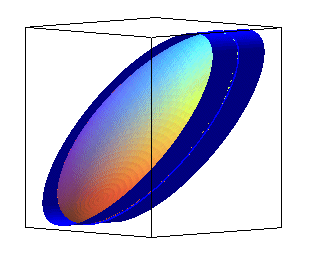
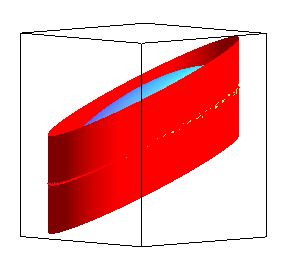
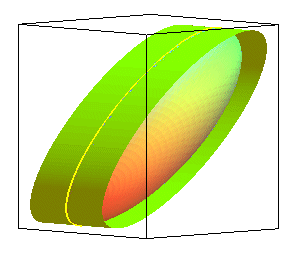
| next curve | previous curve | 2D curves | 3D curves | surfaces | fractals | polyhedra |
VISIBLE OUTLINE OF A SURFACE
| View of an ellipsoid and 3 of its visible outlines, for observers located at infinity in the directions Ox, Oy, Oz and the corresponding contact cylinders. |
 |
|
 |
 |
 |
| Given a direction D, we call visible outline of
a surface (S), in this direction and for an observer at infinity,
the locus of the projections on a plane P perpendicular to D
of the points on the surface for which the tangent plane is parallel to
D.
Therefore, the visible outline is also:
Certain authors refer to the locus, on the surface, of the points for which the tangent plane is parallel to D as the visible outline; we will refer to it as the real visible outline, the other one being the projected one. |
Given a direction D, we call visible outline of
a surface (S), in this direction and for an observer located
at A, the locus of the projections with centre A on a plane
P,
perpendicular to D and not containing A, of the points on
the surface for which the tangent plane passes by A.
Therefore, the visible outline is also:
|
| Visible outline in the direction Oz for an observer
located at infinity:
if the surface is defined by the Cartesian equation (1): f(x,y,z)=0, then the equation of the outline is obtained by eliminating z from (1) and (2): If the curve has a parametric definition as (M(u,v)), we get v = v(u) by writing |
Visible outline in the direction Oz for an observer
located at A(0,0,a):
if the surface is defined by the Cartesian equation (1): f(X,Y,Z)=0, then the equation of the outline in the plane xOy is obtained by eliminating X, Y and Z from (1), (2): If the curve has a parametric definition as (M(u,v)), we get v = v(u) by writing |
Examples:
- the visible outlines of a sphere
are circles (and, conversely, a surface for which all the visible outlines
for an observer at infinity are circles is a sphere);
- the visible outlines (real or projected,
at finite distance or not) of a quadric
are conics (therefore, they are planar);
- the visible outlines of an algebraic
surface of degree n are algebraic surfaces of degree n(n
- 1) (?);
- the projected visible outline of
a tubular surface is composed
of two curves parallel to the
projection on xOy of the central curve. In particular, the visible
outlines of the torus are
the curves parallel to the ellipse, hence their name of toroids.
- the contact cylinder in the direction
D
(resp. with centre A) of a developable
surface is composed of the planes tangent to the surface and parallel
to D (resp. passing by A); the real visible outline is composed
of the directrices for which the tangent plane is parallel to D
(resp. passing by A), and the projected visible outline is composed
of straight lines (two lines for a cone or a cylinder of revolution).
| Opposite, view of a surface and its visible outlines for an observer located at finite distance, the real one in blue, the projected one in black, with, on the right, the contact cone. | 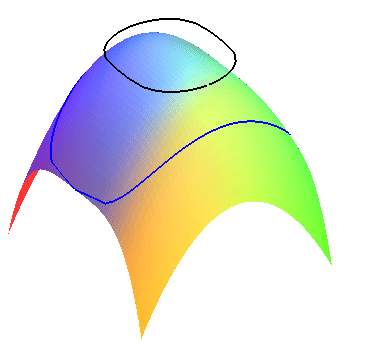 |
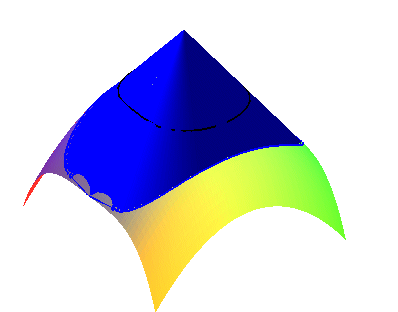 |
Below, views of the cross-cap
with three visible outlines for observers located at infinity in the direction
Oz
(in red), Ox (in blue), and Oy (in yellow).
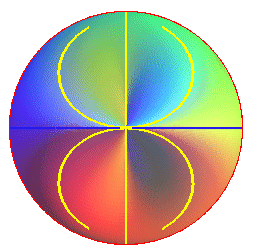 |
||
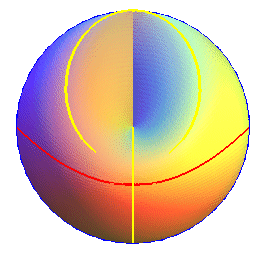 |
 |
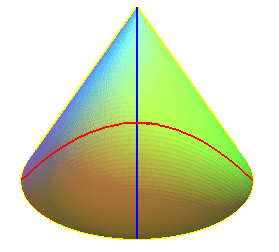 |
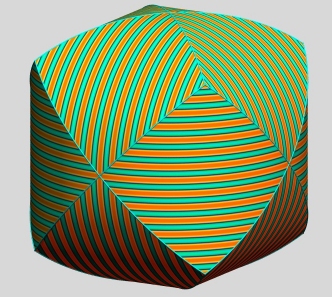
The intersection of three cylinders with perpendicular axes has three visible outlines at infinity in these three directions. They are circles with same radii, but the intersection is not a sphere. Image: Alain Esculier. |
 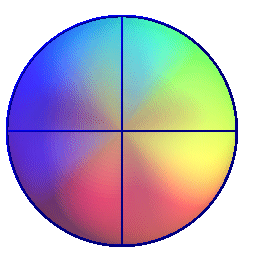 This blistered sphere, whose spherical equation is |
A similar notion is defined in topology: the visible outline
of a set X of the space is the boundary of the projection
of X on a plane P. The projection is orthogonal for an observer
at infinity, and has a centre A for an observer at A. The
two notions coincide for example when X is a surface of class C1,
boundary of a convex set of the space.
| next curve | previous curve | 2D curves | 3D curves | surfaces | fractals | polyhedra |
© Robert FERRÉOL 2019